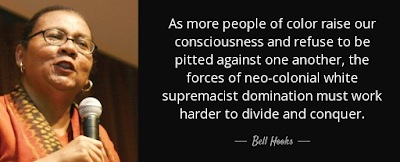The presidential election of 2016 shook the foundations of everything in our society from our discourse, politics, and democracy. For many librarians, the customary semesters filled with reference shifts, instruction sessions, and workshops were thrown for a loop. Fake news and alternative facts entered our lexicon. The change in political landscape had all of us questioning our knowledge and where we get information from. Librarians were looked upon to fill gaps in knowledge--that we’ve always been filling--but the circumstance made people more conscious about it.
While our roles in educating and leading people to truth & knowledge are crucial, there’s more we can do to facilitate discussions about democracy and social justice. This role isn’t quickly ascribed to us, but we must undertake it especially in this political climate, where corporate interests are ruling out over the interests of working people.
This climate calls into question the kinds of events we have and showcase at our libraries. As evidenced in articles, postings on the internet, and at ACRL 2017 in Baltimore, many chose to have workshops about fake news and evaluating information. Naturally, this is our forte. But we can provide spaces for other types of events.
This past semester seeing the need for broader discussions around race and information, I wanted to organize a gathering to discuss these issues. The Men of Color Event was by far one of the best activities I ever helped coordinate at the library. It was done in coordination with a diversity educator at Stevens. Initially, I was trying to have a film showing for The 13th, Ana Duvernay’s critically acclaimed document about the prison system in the United States, but our dates couldn't coordinate. Then the diversity educator suggested a Men of Color event because she had previously organized a Women of Color event on campus.
Most of the events I have organized at my library have been workshops or instructional sessions about finding or being critical about the process of how to use, find, and evaluate information, technology, and media. I use bell hooks, Paulo Freire, and Giroux to guide my teaching so students understand their roles in being active social agents in a world filled with injustice. The Men of Color event wasn’t about those issues. First and foremost it was about learning about allyship, that is, meeting people who have similar interests and understanding about the objective world and how it can affect our consciousness.
Fourteen people attended the event: 12 students and 3 staff members (including myself). We discussed the shared experience of the invisibility of people of color on our campus. By being gathered in one place, it was striking to the staff members the number of young African-American men present. The breakdown of Stevens demographics according to Forbes website is Black or African American 2.3%, Hispanic/Latino, 9.1%, Asian 9.6% and race-ethnicity Unknown is 10.3% percent and predominantly male by 71% to 29% female. All the participants spoke about the importance of people of color finding spaces to speak openly and freely about issues that matter to them especially in today’s political atmosphere.
Beside the library being an active space for students to sit down, talk and feel “safe,” the library should be a place for them to feel strong by the unity and solidarity that they feel in the room. Just as when students use information to fortify an argument or expand their knowledge about a given subject, they should feel strength in numbers in order to continue the discourse and struggle beyond the library doors. These moments could make positive changes on our campus to confront racism, sexism, homophobia, etc and therefore, make our society a better place.
I also proposed that students from the African-American clubs come to the library and research the archives of the university so they could uncover who the people of color at Stevens have been in the past. Furthermore, the library could host an exhibition from the special collections and archives to showcase their research. Thus, the library would provide another space for people of color to express themselves and learn about shared history. Careful consideration about how these collections are used is important and a good model to follow is April Hathcock’s suggestion in her notes about 2016 Untold Histories Unconference. To paraphrase, it should be about the people and not the project.
The Men of Color event brought together the importance of the library and how it should be not only a community’s center for intellectual discourse but also a space for social justice discourse. So much of people of color’s history has either been ignored, obfuscated, or left on dusty shelves that there must be an active drive to shine a light on the total history of the community. Thus, while people of color may feel, and most likely are, a minority at colleges and universities, the library in collaboration with people of color can play a significant role in providing a space for people to engage and for people of color to tell their stories.

No comments:
Post a Comment